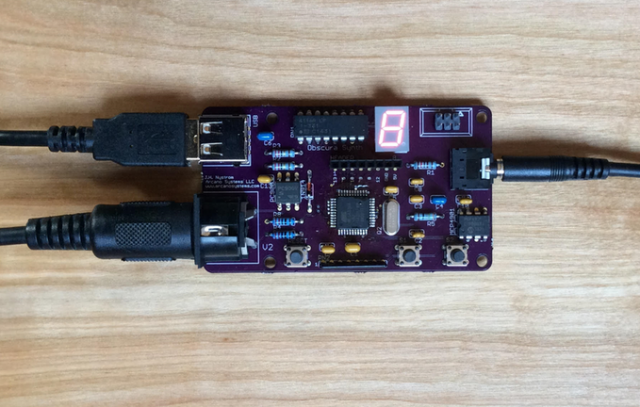
Arcano Systems has introduced the Obscura – an inexpensive minimal chiptunes MIDI synth.
Here’s the official video intro:
Obscura is an Arduino-compatible 8-bit synthesizer that allows you to create NES, C64, and Amiga-style chiptune music by simply connecting a MIDI device.
No programming is required. This monophonic MIDI synth comes programmed with software that includes 16 preset patches.
- Patch 0: 12.5% duty-cycle pulse waveform
- Patch 1: 25% duty-cycle pulse waveform
- Patch 2: 50% duty-cycle pulse waveform
- Patch 3: sawtooth waveform
- Patch 4: 8-bit sine waveform
- Patch 5: 4-bit triangle waveform
- Patch 6: 8-bit triangle waveform
- Patch 7: arpeggiated octaves (25% duty-cycle pulse)
- Patch 8: arpeggiated octaves (50% duty-cycle pulse)
- Patch 9: arpeggiated octaves (8-bit sine)
- Patch A: arpeggiated octaves (8-bit triangle)
- Patch b: vibrato (12.5% duty-cycle pulse)
- Patch C: vibrato (25% duty-cycle pulse)
- Patch d: vibrato (50% duty-cycle pulse)
- Patch E: vibrato (8-bit sine)
- Patch F: vibrato (4-bit triangle)
Users with programming experience will be able create their own custom software for Obscura using the Arduino IDE. (Obscura is based on the Arduino Leonardo platform.) Arduino pins 5, 8, 9, 10, 12, and 13 are broken out for hardware hacking and experimentation.
The Obscura is being developed as a Kickstarter project. The synth is available to project backers starting at US $95.

To me that’s expensive for what it is. Point of views I guess…
And the next comment will be: I can do that myself…
Like clockwork.
I wonder is anyone has done raspberry pi plug ins yet?
Yes, they have been created and they are free
I wonder about the sample rate of this. What makes the NES and C64 so interesting sonically is that thet are running low bitrates at extremely high sample rates. (Almost 1MHZ for the C64 and even higher for the NES). They do not alias but have signifigant quantization noise from the low bitrate and artifacts from the low resolution of envelopes. It’s much more sonically pleasing. Aliasing is just ugly sounding.
Nice info Cheers
Cheers
I am not seeing any info on whether there are any controllable parameters- like it would be nicer if duty cycle could be mapped as well as things like decay, sustain, release, etc.
This looks so simlar to the previous Arcano NES synth, a project that already completed on KickStarter. Is Arduino more powerful or easier to program than AVR?
https://www.kickstarter.com/projects/599725696/arcano-midi-nes-chiptune-synthesizer
Arduino is just a trade name for single board computers that are built around AVR chips (although the newer Arduinos use ARM). An Arduino is simply an AVR chip + basic support parts + USB programming chip to allow programming using a USB interface instead of the AVR ISP header.
The Arduino programming environment deals with the details of programming the chip, and Arduino programs are referred to as ‘sketches’ because it sounds less threatening than ‘code’.
Would it kill anybody to make cases for these things? The only thing keeping me from getting products like this. I don’t like exposed electronics. Sue me. The rest is great though.